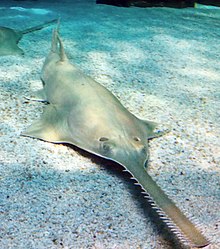| Sawfish Temporal range:
| |
|---|---|

| |

| |
| Largetooth sawfish, Pristis pristis (above), Green sawfish, Pristis zijsron (below) | |
| Scientific classification | |
| Domain: | Eukaryota |
| Kingdom: | Animalia |
| Phylum: | Chordata |
| Class: | Chondrichthyes |
| Subclass: | Elasmobranchii |
| Order: | Rhinopristiformes |
| Family: | Pristidae Bonaparte, 1838 |
| Genera | |
| |
Sawfish, also known as carpenter sharks, are a family of rays characterized by a long, narrow, flattened rostrum, or nose extension, lined with sharp transverse teeth, arranged in a way that resembles a saw. They are among the largest fish, with some species reaching lengths of about 7–7.6 m (23–25 ft).[1] They are found worldwide in tropical and subtropical regions in coastal marine and brackish estuarine waters, as well as freshwater rivers and lakes. All species are critically endangered.[2]
They should not be confused with sawsharks (order Pristiophoriformes) or the extinct sclerorhynchoids (order Rajiformes) which have a similar appearance, or swordfish (family Xiphiidae) which have a similar name but a very different appearance.[3][4]
Sawfishes are relatively slow breeders and the females give birth to live young.[1] They feed on fish and invertebrates that are detected and captured with the use of their saw.[5] They are generally harmless to humans, but can inflict serious injuries with the saw when captured and defending themselves.[6]
Sawfish have been known and hunted for thousands of years,[7] and play an important mythological and spiritual role in many societies around the world.[8]
Once common, sawfish have experienced a drastic decline in recent decades, and the only remaining strongholds are in Northern Australia and Florida, United States.[4][9] The five species are rated as Endangered or Critically Endangered by the IUCN.[10] They are hunted for their fins (shark fin soup), use of parts as traditional medicine, their teeth and saw. They also face habitat loss.[4] Sawfish have been listed by CITES since 2007, restricting international trade in them and their parts.[11][12] They are protected in Australia, the United States and several other countries, meaning that sawfish caught by accident have to be released and violations can be punished with hefty fines.[13][14]
- ^ a b Last; White; de Carvalho; Séret; Stehmann; Naylor (2016). Rays of the World. CSIRO. pp. 57–66. ISBN 978-0-643-10914-8.
- ^ Dulvy; Davidson; Kyne; Simpfendorfer; Harrison; Carlson; Fordham (2014). "Ghosts of the coast: Global extinction risk and conservation of sawfishes" (PDF). Aquatic Conservation: Marine and Freshwater Ecosystems. 26 (1): 134–153. doi:10.1002/aqc.2525.
- ^ Wueringer, B.E.; L. Squire Jr.; S.P. Collin (2009). "The biology of extinct and extant sawfish (Batoidea: Sclerorhynchidae and Pristidae)". Review in Fish Biology and Fisheries. 19 (4): 445–464. Bibcode:2009RFBF...19..445W. doi:10.1007/s11160-009-9112-7. S2CID 3352391.
- ^ a b c Harrison, L.R.; N.K. Dulvy, eds. (2014). Sawfish: A Global Strategy for Conservation (PDF). IUCN Species Survival Commission's Shark Specialist Group. ISBN 978-0-9561063-3-9.
- ^ Wueringer, B. "How sawfish use their saw". Sawfish Conservation Society. Archived from the original on 30 November 2017. Retrieved 17 November 2017.
- ^ Froese, Rainer; Pauly, Daniel (eds.). "Family Pristidae". FishBase. November 2017 version.
- ^ Moore, A.L.B. (2015). "A review of sawfishes (Pristidae) in the Arabian region: diversity, distribution, and functional extinction of large and historically abundant marine vertebrates". Aquatic Conservation. 25 (5): 656–677. Bibcode:2015ACMFE..25..656M. doi:10.1002/aqc.2441.
- ^ "Cultural Importance of Sawfish". Florida Fish and Wildlife Conservation Commission. Archived from the original on 1 December 2017. Retrieved 17 November 2017.
- ^ Platt, J.R. (2 July 2013). "Last Chance for Sawfish?". Scientific American. Retrieved 17 November 2017.
- ^ "Pristidae". IUCN Red List. International Union for Conservation of Nature. Retrieved 17 November 2017.
- ^ Black, Richard (June 11, 2007). "Sawfish protection acquires teeth". BBC News.
- ^ "Appendices I, II and III". CITES. 4 October 2017. Retrieved 17 November 2017.
- ^ Slezak, M. (3 August 2016). "Queensland fisherman caught selling bills of endangered sawfish". The Guardian. Retrieved 17 November 2017.
- ^ "Why Report Sawfish Encounters?". University of Florida. 2017-05-16. Retrieved 17 November 2017.